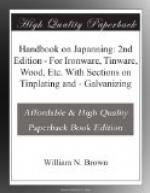manner as the common, except as regards the substances
used in polishing, which, where a pure white or the
greater clearness or purity of other pigments is in
question, should be itself white, while the browner
sorts of polishing dust, as being cheaper and doing
their business with greater dispatch, may be used
in other cases. The pieces of work to be varnished
should be placed near the fire or in a warm room and
made perfectly dry, and then the varnish may be applied
with a flat camel-hair brush made for the purpose.
This must be done very rapidly, but with great care;
the same place should not be passed twice over in
laying on one coat if it can possibly be avoided.
The best way of proceeding is to begin in the middle
and pass the brush to one end, then with another stroke
from the middle pass it to the other end, taking care
that before each stroke the brush be well supplied
with varnish; when one coat is dry another must be
laid over it in like manner, and this must be continued
five or six times. If on trial there be not a
sufficient thickness of varnish to bear the polish
without laying bare the painting or ground colour underneath
more varnish must be applied. When a sufficient
number of coats of varnish is so applied the work
is fit to be polished, which must be done in common
work by rubbing it with a piece of cloth or felt dipped
in tripoli or finely ground pumice-stone. But
towards the end of the rubbing a little oil of any
kind must be used with the powder, and when the work
appears sufficiently bright and glossy it should be
well rubbed with the oil alone to clean it from the
powder and to give it a still greater lustre.
In the case of white grounds, instead of the tripoli,
fine putty or whiting should be used, but they should
be washed over to prevent the danger of damaging the
work from any sand or any other gritty matter that
may happen to be mixed with them. It greatly
improves all kinds of japan work to harden the varnish
by means of heat, which, in every degree that can
be applied short of what would burn or calcine the
matter, tends to give it a firm and strong texture
where metals form the body; therefore a very hot stove
may be used, and the stoving may be continued for a
considerable time, especially if the heat be gradually
increased. But where wood or papier-mache is
in question, heat must be applied with great caution.
SECTION III.
Japanning or enamelling metals.
In japanning metals, all good work of which should be stoved, they have to be first thoroughly cleaned, and then the japan ground applied with a badger or camel-hair brush or other means, very carefully and evenly. Metals usually require from three to five coats, and between each application must be dried in an oven heated from 250 deg. to 300 deg. F.—about 270 deg. being the average. It has already been seen that the best grounds for japanning are formed




